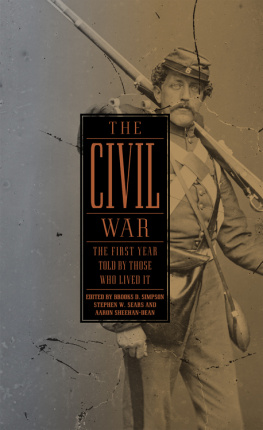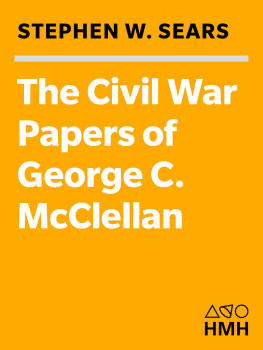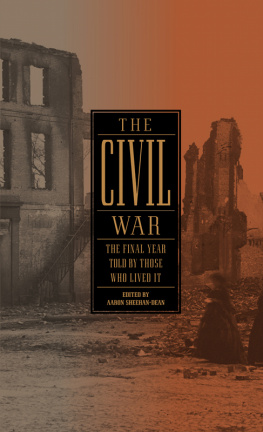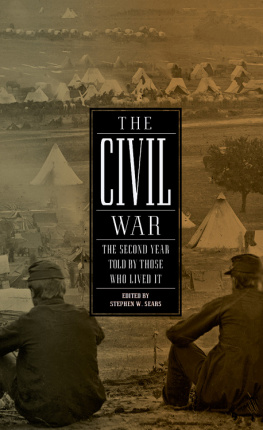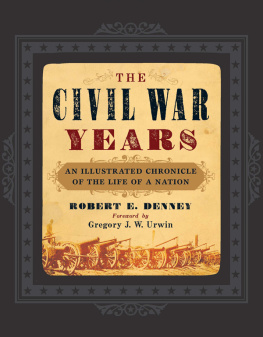
THE CIVIL WAR

THE FIRST YEAR TOLD
BY THOSE WHO LIVED IT

Edited by
Brooks D. Simpson
Stephen W. Sears
Aaron Sheehan-Dean

THE LIBRARY OF AMERICA
Volume compilation, preface, introduction, notes, and chronology copyright 2011 by Literary Classics of the United States, Inc., New York, N.Y.
All rights reserved.
No part of the book may be reproduced commercially by offset-lithographic or equivalent copying devices without the permission of the publisher.
Some of the material in this volume is reprinted by permission of the holders of copyright and publication rights.
See Note on the Texts on for acknowledgments.
Distributed to the trade in the United States by Penguin Group (USA) Inc. and in Canada by Penguin Books Canada Ltd.
THE LIBRARY OF AMERICA, a nonprofit publisher, is dedicated to publishing, and keeping in print, authoritative editions of Americas best and most significant writing. Each year the Library adds new volumes to its collection of essential works by Americas foremost novelists, poets, essayists, journalists, and statesmen.
If you would like to request a free catalog and find out more about The Library of America, please visit with your name and address. Include your e-mail address if you would like to receive our occasional newsletter with items of interest to readers of classic American literature and exclusive interviews with Library of America authors and editors (we will never share your e-mail address).
Library of Congress Control Number: 2010931718
Print ISBN 978-1-59853-088-9
eISBN 978-1-59853-138-1
First eBook Edition: January 2012

The Library of America212
The Civil War:
The First Year Told by Those Who Lived It
is published with support from
THE ANDREW W. MELLON FOUNDATION
and
THE NATIONAL ENDOWMENT
FOR THE HUMANITIES
Preface
Has there ever been another historical crisis of the magnitude of 186165 in which so many people were so articulate?
Edmund Wilson
T HIS Library of America volume is the first in a four-volume series bringing together memorable and significant writing by participants in the American Civil War. Each volume in the series covers approximately one year of the conflict, from the election of Abraham Lincoln in November 1860 to the end of the war in the spring of 1865, and presents a chronological selection of documents from the broadest possible range of authoritative sourcesdiaries, letters, speeches, military reports, newspaper articles, memoirs, poems, and public papers. Drawing upon an immense and unique body of American writing, the series offers a narrative of the war years that encompasses military and political events and their social and personal reverberations. Created by persons of every class and condition, the writing included here captures the American nation and the American language in the crucial period of their modern formation. Selections have been chosen for their historical significance, their literary quality, and their narrative energy, and are printed from the best available sources. The goal has been to shape a narrative that is both broad and balanced in scope, while at the same time doing justice to the number and diversity of voices and perspectives preserved for us in the writing of the era.
Introduction
A s Abraham Lincoln looked out from the East Portico of the United States Capitol on March 4, 1865, he saw assembled before him a throng of Americans, each of whom had been marked in some way by nearly four long years of war. It had been precisely four years since he had stood in the same place and expressed his hope that somehow war could be avoided. Now he recalled that moment as he delivered his Second Inaugural Address. All dreaded itall sought to avert it, he declared. Yet that had not been enough. Both parties deprecated war; but one of them would make war rather than let the nation survive; and the other would accept war rather than let it perish. And the war came.
The letters, diaries, speeches, poems, memoirs, and other documents collected in this volume help us understand how and why that war came, and how Americans, North and South, white and black, male and female, experienced secession and armed conflict as it moved across the land. Few of them doubted that slavery was, as Lincoln said in his Second Inaugural, somehow, the cause of the war. Yet, as the President also recalled, no one expected for the war, the magnitude, or the duration, which it has already attained. Most Americans looked for an easier triumph, and a result less fundamental and astounding than what eventually happened, including the destruction of slavery. It is often difficult for readers today to grasp just how revolutionary and astonishing the Civil War was to those who experienced it, and how events that we may believe to have been practically inevitable were at best barely conceivable to many Americans at the time. By reading what people wrote as history unfolded before them, we can gain a better appreciation for what people thought was at stake, and for what the war was all about.
In the same address Lincoln spoke of the bond-mans two hundred and fifty years of unrequited toil. The origins of the Civil War can indeed be traced back to 1619 and the beginnings of African slavery in Virginia, and then forward through the compromises regarding slavery adopted by the Constitutional Convention, the spread of cotton cultivation throughout the Deep South, the Missouri Compromise of 1820 that prohibited slavery in most of the Louisiana Purchase territory, and the emergence of the abolitionist movement in the 1830s. With the outbreak of the U.S.-Mexican War in 1846, the pace of events quickened, as the prospect of acquiring new territory revived the sectional controversy over the expansion of slavery. An attempt by Henry Claythe seventy-three-year-old Kentucky Whig celebrated for his role in passing the Missouri Compromiseto fashion a new compromise in 1850 faltered when his Omnibus Bill failed to win Senate approval. It fell to a younger man, the ambitious Illinois Democrat Stephen A. Douglas, to forge two different sectionally-based coalitions, one to pass anti-slavery measuresthe admission of California as a free state, the abolition of the slave trade in the District of Columbiaand another to adopt proslavery onesa new, stronger fugitive slave law, the organization of New Mexico and Utah as territories where slavery would be permitted. None of these measures were supported by a majority of both Northern and Southern senators and representatives, and what became known as the Compromise of 1850 was more of an uneasy truce.
In 1854 Stephen A. Douglas ended the truce he had helped fashion four years earlier. Hoping to win Southern support for the construction of a transcontinental railroad along a northern route, Douglas won passage of the Kansas-Nebraska Act, which repealed the Missouri Compromise and allowed the question of whether slavery would be permitted in the two newly-organized territories to be decided by their voters. Over the next two years, the passage of the act led to armed conflict in Kansas, the bloody caning of Charles Sumner on the Senate floor, the formation of the Republican Party, and the resurgence of the political career of Abraham Lincoln.
Next page
